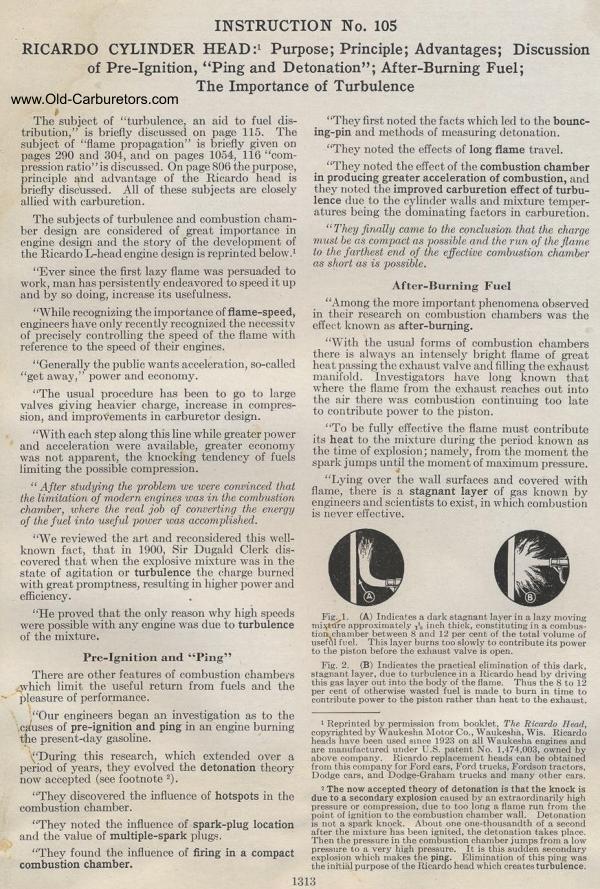RICARDO CYLINDER HEAD:
1 Purpose; Principle; Advantages; Discussion
of Pre-Ignition, "Ping and Detonation"; After-Burning
Fuel;
The Importance of Turbulence
The subject of "turbulence, an aid to fuel distribution," is
briefly discussed on page 115. The subject of "flame propagation" is
briefly given on pages 290 and 301, and on pages 1054, 116 "compression
ratio" is discussed. On page SO6 the purpose, principle and
advantage of the Ricardo head is briefly discussed. All of these
subjects are closely allied with carburetion.
The subjects of turbulence and combustion chamber design are considered
of great importance iii engine design and the story of the development
of the Ricardo L-head engine design is reprinted below.'
"Ever since the first lazy flame was persuaded to work, man
has persistently endeavored to speed it up and by so doing, increase
its usefulness.
"While recognizing the importance of flame-speed, engineers
have only recently recognized the necessity of precisely controlling
the speed of the flame with reference to the speed of their engines.
"Generally the public wants acceleration, so-called "get
away," power and economy.
"The usual procedure has been to go to large valves giving
heavier charge, increase in compression, and improvements in carburetor
design.
"With each step along this line while greater power and acceleration
were available, greater economy was not apparent, the knocking
tendency of fuels limiting the possible compression.
"After studying the problem we were convinced that the limitation
of modern engines was in the combustion chamber, where the real
job of converting the energy of the fuel into useful power was
accomplished.
"We reviewed the art and reconsidered this well-known fact,
that ii, 190(1, Sir Dugald Clerk discovered that when the explosive
mixture was in the state of agitation or turbulence the charge
burned with great promptness, resulting in higher power and efficiency.
"He proved that the only reason why high speeds were possible
with any engine was due to turbulence of the mixture.
Pre-Ignition and "Ping"
There are other features of combustion chambers which limit the
useful return from fuels and the pleasure of performance.
"Our engineers began an investigation as to the causes of pre-ignition
and ping in an engine burning the present-day gasoline.
`During this research, which extended over a period of years, they
evolved the detonation theory now accepted (see footnote 2).
"They discovered the influence of hotspots in the combustion
chamber.
"They noted the influence of spark-plug location and the value
of multiple-spark plugs.
"They found the influence of firing in a compact combustion
chamber.
"They first noted the facts which led to the bouncing-pin and
methods of measuring detonation.
"They noted the effects of long flame travel.
"They noted the effect of the combustion chamber in producing
greater acceleration of combustion, and they noted the improved carburetion
effect of turbulence due to the cylinder walls and mixture temperatures
being the donnnating factors in carburetion.
"Then flintily come to the conclusion that the charge must be
as compact as possible cued the hate of the flame to the farthest
end of the effective combustion chamber as short as is possible.
After-Burning Fuel
"Among the more important phenomena observed in their research
on combustion chambers was the effect known as after-burning.
"With the usual forms of combustion chambers there is always
an intensely bright flame of great heat passing the exhaust valve
and filling the exhaust manifold. Investigators have long known that
where the flame from the exhaust reaches out into the air there was
combustion continuing too late to contribute power to the piston.
"To be fully effective the flame must contribute its heat to
the mixture during the period known as the tinge of explosion; namely,
from the moment the spark juleps until the moment of maximum pressure.
"Lying over the wall surfaces and covered with flame, there
is a stagnant layer of gas known by engineers and scientists to exist,
in which combustion is never effective.
Fig. 1. (A) Indicates a (lark stagnant layer in a lazy moving ntiytti're
approximately 11„ Melt thick, constituting in a combustion
chamber between 8 and 12 per cent of the total volume of useful
fuel. This layer burns too slowly to contribute its power to the
piston before the exhaust valve is open.
Fig. 2. (B) Indicates the practical elimination of this dark, stagnant
layer, due to turbulence in a Ricardo head by driving this gas
layer out into the body of the flame. Thus the 8 to 12 per cent
of otherwise wasted fuel is made to burn in time to contribute
power to the piston rather than heat to the exhaust.
Reprinted by permission from booklet, The Ricardo Mead, copyrighted
by Waukesha Motor Co., Waukesha, Wis. Ricardo heads have been used
since 11123 on all Waukesha engines and are manufactured under
U.S. patent No. 1,474,003, owned by above company. Ricardo
replacement heads can be obtained from this company for Ford cars, Ford
trucks,
Fordson tractors, Dodge cars, and Dodge-Uraltam trucks and many
other cars.
2 The now accepted theory of detonation is that the knock is due
to a secondary explosion caused by an extraordinarily high pressure
or compression, due to too long a flame run front the point of
ignition to the combustion chamber wall. Detonation is not a spark
knock. About one one-thousandth of a second after the mixture has
been ignited, the detonation takes place. Then the pressure in
the combustion chamber jumps front a low pressure to a very high
pressure. It is this sudden secondary explosion which makes the
ping. Elimination of this ping was the initial purpose of the Ricardo
head which creates turbulence.
Previous page 1927
Supplement Home Next page 
|